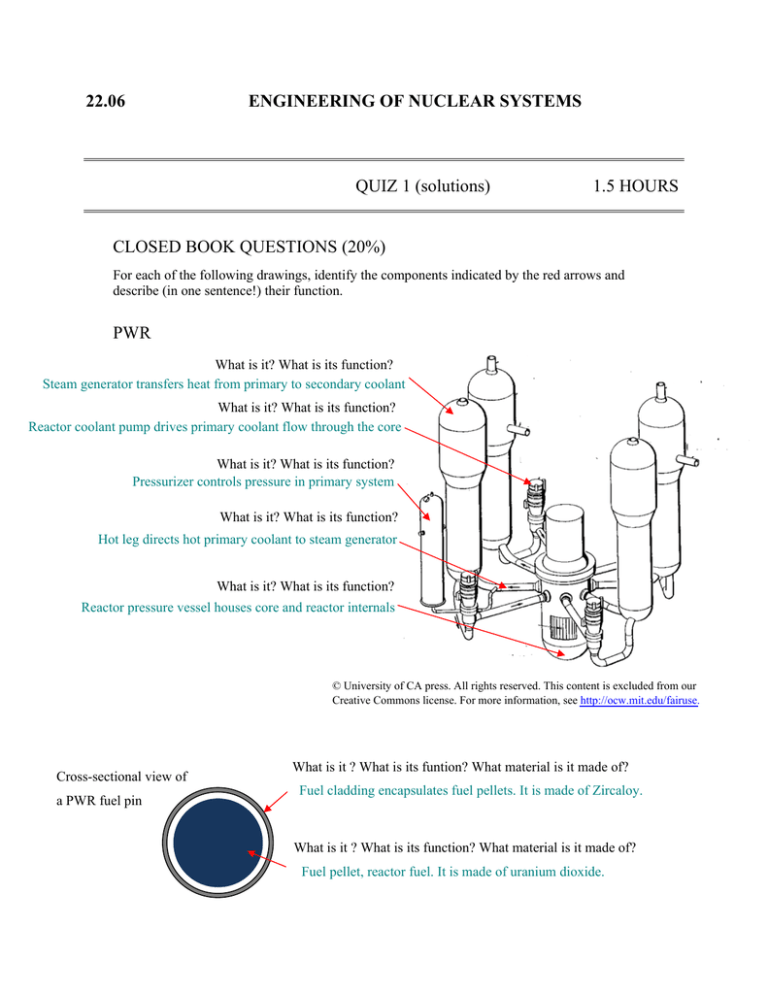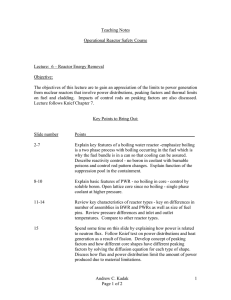
22.06
ENGINEERING OF NUCLEAR SYSTEMS
QUIZ 1 (solutions)
1.5 HOURS
CLOSED BOOK QUESTIONS (20%)
For each of the following drawings, identify the components indicated by the red arrows and describe (in one sentence!) their function. PWR
What is it? What is its function?
Steam generator transfers heat from primary to secondary coolant
What is it? What is its function?
Reactor coolant pump drives primary coolant flow through the core
What is it? What is its function?
Pressurizer controls pressure in primary system
What is it? What is its function?
Hot leg directs hot primary coolant to steam generator
What is it? What is its function?
Reactor pressure vessel houses core and reactor internals
© University of CA press. All rights reserved. This content is excluded from our
Creative Commons license. For more information, see http://ocw.mit.edu/fairuse.
Cross-sectional view of
a PWR fuel pin
What is it ? What is its funtion? What material is it made of?
Fuel cladding encapsulates fuel pellets. It is made of Zircaloy.
What is it ? What is its function? What material is it made of?
Fuel pellet, reactor fuel. It is made of uranium dioxide.
What is it? What is its function? What material is it made of?
Control rod cluster (or spider) can be used to control power and shutdown reactor
It is made of neutron absorbers (B, Cd, In, Ag…)
Public domain image from wikipedia.
What is it?
What is its function? What material is it made of?
Spacer grid prevents fuel rod vibration, promotes heat transfer.
It is made of Zircaloy.
© source unknown. All rights reserved. This content is excluded from our
Creative Commons license. For more information, see http://ocw.mit.edu/fairuse.
BWR
What is it? What
. is its function?
Steam dryer removes droplets from steam
S�
What is it? What is its function?
S� ��� D�����
S� ��� S� ��������
Steam separators separates steam from liquid
�
What is it? What is its function?
D������ F���
J�� P
C� ��
R������������
P� ��
Recirculation pump drives flow through the core
What is it? What is its function?
Jet pump boosts flow through the core
© source unknown. All rights reserved. This content is excluded from our
Creative Commons license. For more information, see http://ocw.mit.edu/fairuse.
What is it? What is its function?
Water rod enhances moderation in center of fuel assembly
What is it? What is its function? What material is it made of?
Cruciform control blade used to control power and shutdown reactor
It is made of neutron absorbers
What is it? What is its function? What material is it made of?
Fuel assembly duct prevent steam drifting from one fuel assembly
to the next. It is made of Zircaloy.
© source unknown. All rights reserved. This content is excluded from our
Creative Commons license. For more information, see http://ocw.mit.edu/fairuse.
22.06
ENGINEERING OF NUCLEAR SYSTEMS
OPEN BOOK
QUIZ 1 (solutions)
Short Questions (10% each)
(adapted from Shultis & Faw textbook)
a) The duration of the trip is 60,000/(201.852) 1620 hr or 5.83106 s. The total electric energy needed for the trip is 181065.83106 1.051014 J, which requires 1.051014/0.25 4.201014
J of thermal energy or 4.201014 /(200106 1.610-19) 1.3121025 fissions. Therefore, the total consumption of U-235 (including fissions and parasitic captures) is 1.3121025(678/577)
1.541025 atoms of U-235, which is 1.541025/(6.0221023)0.235 6 kg of U-235.
b) The decay power for a reactor that had operated for infinitely long time prior to shutdown is: Q decay / Q 0 0.066t 0.2
Setting the LHS equal to 0.005 and solving for t, we get t=4.007105 s or 4.6 days.
c) The total number of target nuclei in the sample is Nav m/A, where Nav is the Avogadro’s number. The total reaction rate (scatterings per second) within the sample is (Nav m/A s ). Therefore, the time it takes all target nuclei on average to scatter at least once is (Nav m/A)/(Nav m/A s ) = 1/(s
). The implicit assumption made is that the absorption cross-section of the material is negligible, so that the total number of target nuclei does not change with time.
Problem 1 (50%) – Temperature distribution within a fuel pellet with non-uniform
heat generation (adapted from Duderstadt & Hamilton textbook)
i) The linear power can be obtained from the following integration:
R
R
0
0
q q(r)2rdr q0[1 a(r / R) 2 ]2rdr q0R 2 (1 a / 2)
(1)
ii) The heat equation in the pellet (for constant thermal conductivity) is: kf
1 d dT
[r
] q(r) 0
r dr dr
The boundary conditions are as follows:
d dT
rq
[r
] 0 [1 a(r / R) 2 ]
dr dr
kf
(2)
T=Tfo
at r=R
dT
0
dr
at r=0
Integrate Eq 2 from r=0 and a generic location r, to get:
r
dT
dT
r
dr
dr
r0
q0 r 2
r4
[ a 2]
4R
kf 2
dT
q
r3
0 [r a 2 ]
2R
dr
2k f
(3)
where the second boundary condition was imposed. Integrating Eq 3 from r=R and a generic
location r, we get:
T (r) T fo
q0 r 2
r4
q R 2
R4
[ a 2 ] 0 [ a 2 ]
2k f 2
8R
2k f 2
8R
(4)
Where the first boundary condition was imposed. The centerline temperature is found by setting
r=0 in Eq 4:
Tmax T fo
q' 4 a
4k f 4 2a
(5)
where Eq 1 was used to substitute q0 with q. iii) Substituting the numerical values into Eq 5, we get Tmax1044C. iv) As derived in class, the centerline temperature for the case of uniform heat generation and constant thermal conductivity is:
Tmax T fo
q'
1063C
4k f
The temperature in the non-uniform case is lower because, on average, the energy (heat) has a
shorter distance to ‘travel’ to the heat sink (coolant) than in the uniform heat generation case.
MIT OpenCourseWare
http://ocw.mit.edu
22.06 Engineering of Nuclear Systems
Fall 2010
For information about citing these materials or our Terms of Use, visit: http://ocw.mit.edu/terms.


